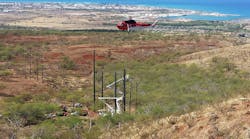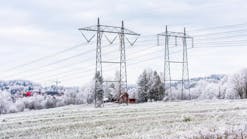Login to download this article in pdf format.
Hawaiian Electric Co. has nearly 1300 structures on its 28 138-kV transmission circuits that span the island of Oahu. The system is isolated with no interconnections to other utilities. A single structure failure should not cause customer outages, but the system is at an increased risk for overload and outages if additional failures occur. The 138-kV transmission structures generally are one of the following types: wood poles, steel poles, fiberglass poles, aluminum frames, and steel or aluminum lattice towers. The wide variety of structures is needed for the topography of the island, ranging from mountain ridges, valleys, side slopes and urban areas.
Steel and wood poles comprise most of the structures, typically located in the mountainous areas of Oahu. Currently, more than 35% of the transmission structures have been in service more than 40 years and nearly 20% have been in service more than 50 years. Because of its aging transmission infrastructure, Hawaiian Electric has begun replacing the existing transmission structures.
Access and Accessibility
In addition to the environmental and cultural challenges, right-of-way (ROW) agreements can be difficult to obtain. As with most construction, the ability to acquire new rights-of-way adjacent to an existing line is preferred to ease construction restraints. However, it is becoming more problematic and costlier for utilities across the United States to purchase ROW. Imagine how much harder this can be on an island where land is held at a very high premium, essentially eliminating that option. With adjacent property difficult to procure, structures must be installed as close to the existing centerline as possible.
Outage and system limitations because of the closed transmission system require the line to be placed back in service every night. Hawaiian Electric does not have the ability to rely on another utility to help provide backup and system redundancy. To increase construction efficiency, the new structures must closely match the conductor geometry of the existing structures. During construction, this prevents phase-to-phase clearance issues and line-angle changes that could potentially exceed the design parameters of the existing structures.
To compound this further, the double- and triple-circuit structures are being split to individual parallel single-circuit lines, to decrease the quantity of outage conflicts between circuits connecting the same substations. All circuits attached to the structure being replaced require outages for the duration of construction. Renewable energy source interconnections are increasing on the transmission circuits, making intermittent curtailment a growing concern because it impacts work scheduling.
Environmental durability is a factor when determining structure types. Oahu is home to many climate zones and the same transmission line may cross through several, if not all, of them. Coastal regions with high levels of salt corrosion and shallow water tables, tropical areas with high volumes of rain and humidity year-round, dry desert-like areas with substantial levels of very fine dust and high levels of ultraviolet radiation—all these environments must be considered. Rotting wood poles and corroding steel structures long have been a problem. In addition to weather, insects are prevalent. Termites in Hawaii have a particularly aggressive appetite for treated wood poles.
After all the challenges have been addressed, crews still must get to the structures to replace them. Accessibility to transmission lines and structures is arguably the biggest factor to consider. A large percentage of transmission structures on Oahu are in remote areas that cannot be accessed by vehicles. Because of the cultural sensitivities and land rights, new roads rarely can be built. Therefore, helicopters are the primary means available to transport crews, materials and structures to many locations.
Of course, there are limitations to what helicopters can carry safely. For example, a McDonnell Douglas MD500 helicopter generally is used to ferry personnel and equipment to a jobsite when the payload is less than 1000 lb (454 kg), whereas 3500 lb (1588 kg) is the maximum weight that can be transported with a Bell Huey. The Huey typically is used for moving lighter material and foundation concrete. For many years, it was the largest helicopter available to Hawaiian Electric. Occasionally the much larger Sikorsky S-61 helicopter is brought on the island to increase construction efficiency as it can carry up to 7500 lb (3402 kg). The limitations of the helicopters dictate that any new structure must have the ability to be segmented and carried in sections as well as easily framed aerially.
Standard Structures
Having a consistent structure family—with the versatility to support a wide range of wind and weight spans that can be used anywhere on the island, regardless of accessibility—is preferred. In remote mountainous areas, topography governs where the structure is placed instead of the engineered target ruling span. Ridges and peaks are prime spots to locate the structures. However, finding areas large enough with the existing structures in place leaves few options. Structures on Oahu may see span variations as severe as 200 ft (61 m) on one side and 2000 ft (610 m) on the other side. Some also must withstand significant vertical changes ranging up to almost 3000 ft (914 m) in a single span.
With a standard structure type and family, it is easier to train crews, develop material standards and prepare for emergencies. Being in the middle of the Pacific Ocean, where it takes considerably longer to get supplies, Hawaiian Electric has to standardize and prepare differently than mainland utilities, which can obtain poles faster.
Finding a structure that can satisfy Oahu’s diverse needs—be self-supporting with a small footprint, corrosion- and insect-resilient, versatile and cost-effective, within helicopter lifting capacities—all point to steel monopole structures on concrete foundations. Steel tends to corrode and rust in caustic environments such as those found on Oahu, so—in addition to hot-dip galvanizing—corrosion-resistant powder coating is applied to the steel poles to help protect against the environment. Section weights are kept below helicopter maximum lift capacity, and helicopter guides are implemented to aid construction.
The steel poles also are relatively easy to assemble, which is a requirement because new structures must be built within existing easements. Load cases with high wind, broken wire or failure containment were developed to ensure reliability and structural integrity well into the future for Hawaiian Electric’s 138-kV transmission system.
Digging Foundations
The utility uses shaft foundations and micropiles for steel pole transmission structure replacements. Where locations are accessible, foundations excavated by vehicle-mounted drills are the most uniform and cost-effective. Foundations inaccessible by large vehicles either are dug by hand or have a micropile foundation. Although labor-intensive and costly, hand digging has a long history in Hawaii for the installation of structural foundations because of the steep and inaccessible terrain. Uniformity of shafts and production rates depend on the type of material encountered during excavation.
On a typical Hawaiian Electric transmission line project, multiple specialized foundation contractors are used because both accessible and inaccessible foundations are required. Using multiple contractors is cost-effective and enables Hawaiian Electric to reduce a project’s length as well as the length of outages on the transmission system.
Planning and Coordination
Helicopter landing zones and staging areas must be acquired during project planning. Flight plans must be submitted to the U.S. Federal Aviation Administration for all helicopter flights. The Sikorsky S-61 heavy-lift helicopter is a restricted-category helicopter because of its previous use in the military. This designation means the helicopter is not allowed to fly in or over populated areas, thereby requiring additional planning when choosing landing zones. Road closures also are required when a helicopter transporting a load needs to cross the roads. To prevent additional coordination and permitting as well as increased cost to close highways, materials are trucked to selected staging areas and then flown to the site, eliminating the need to cross roadways and populated areas.
When stringing new conductor, shield wire and optical ground wire (OPGW) are installed on the new structures, many of the same issues are encountered. Helicopters can be used to string the wire in remote areas, but the heavy conductor reels and construction cable trailers exceed the weight limits of the helicopters, so finding locations to stage and string from is extremely challenging in the remote areas of the island. Finding one location to put pulling equipment is difficult enough but finding a second location for the conductor pull cart is rare. Potential locations that will allow vehicle access for fiber splicing are scouted early in the design process. Many times, the largest reels available are used and there is barely enough OPGW left for it to be spliced and coiled at the base of the structure.
Vegetation management on Oahu is a continuous process. The tropical climate fosters plant and grass growth year-round. Coordinating vegetation management with both surveying and construction efforts requires frequent progress update meetings. In remote areas, landing zones must be cleared of such vegetation before helicopters can land safely.
Making it Work
Despite all the obstacles discussed, Hawaiian Electric has been able to team up with HDR to develop the groundwork to build a solid structure-replacement program. The truest test for such challenges is the ability to complete a project. Construction is ongoing, but much of the backbone transmission lines that support most of the island have been rebuilt. The Oahu power grid has benefited from a more robust and reliable transmission system that is built to last well into the future.






